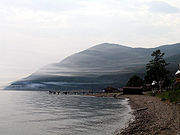
Baikal Mountains
Encyclopedia

Lake Baikal
Lake Baikal is the world's oldest at 30 million years old and deepest lake with an average depth of 744.4 metres.Located in the south of the Russian region of Siberia, between Irkutsk Oblast to the northwest and the Buryat Republic to the southeast, it is the most voluminous freshwater lake in the...
in southern Siberia
Siberia
Siberia is an extensive region constituting almost all of Northern Asia. Comprising the central and eastern portion of the Russian Federation, it was part of the Soviet Union from its beginning, as its predecessor states, the Tsardom of Russia and the Russian Empire, conquered it during the 16th...
, Russia
Russia
Russia or , officially known as both Russia and the Russian Federation , is a country in northern Eurasia. It is a federal semi-presidential republic, comprising 83 federal subjects...
. The Central Siberian Plateau
Central Siberian Plateau
The Central Siberian Plateau is made up of sharply demarcated surfaces of varying altitudes occupying most of Siberia between the Yenisei and Lena rivers. It extends over an area of 3.5 million km². The highest point is the Putoran Mountains rising to 1701 m. To the north of the plateau are...
is bounded on the south by the Eastern Sayan Mountains
Sayan Mountains
The Sayan Mountains are a mountain range between northwestern Mongolia and southern Siberia, Russia.The Eastern Sayan extends from the Yenisei River at 92° E to the southwest end of Lake Baikal at 106° E...
and the Baikal Mountains.
The Baikal Mountains are the origin of the Lena River
Lena River
The Lena is the easternmost of the three great Siberian rivers that flow into the Arctic Ocean . It is the 11th longest river in the world and has the 9th largest watershed...
. The mountains around Lake Baikal are densely wooded with Grey Alder
Grey Alder
Alnus incana is a species of alder with a wide range across the cooler parts of the Northern Hemisphere....
, Eurasian Aspen
Aspen
Populus section Populus, of the Populus genus, includes the aspen trees and the white poplar Populus alba. The five typical aspens are all native to cold regions with cool summers, in the north of the Northern Hemisphere, extending south at high altitudes in the mountains. The White Poplar, by...
, Downy Birch
Downy Birch
Betula pubescens is a species of birch, native and abundant throughout northern Europe, Iceland, northern Asia and also Greenland....
, Siberian Larch
Siberian Larch
The Siberian Larch or Russian Larch is a frost-hardy tree native to western Russia, from close to the Finnish border east to the Yenisei valley in central Siberia, where it hybridises with the Dahurian Larch L...
, Siberian Fir
Siberian Fir
Abies sibirica, the Siberian Fir, is a coniferous evergreen tree native to the taiga east of the Volga River and south of 67°40' North latitude in Siberia through Turkestan, northeast Xinjiang, Mongolia and Heilongjiang.-Distribution:...
, Scots Pine
Scots Pine
Pinus sylvestris, commonly known as the Scots Pine, is a species of pine native to Europe and Asia, ranging from Scotland, Ireland and Portugal in the west, east to eastern Siberia, south to the Caucasus Mountains, and as far north as well inside the Arctic Circle in Scandinavia...
, and Siberian Spruce
Siberian Spruce
Siberian Spruce is a spruce native to Siberia, from the Ural Mountains east to Magadan Oblast, and from the arctic tree line south to the Altay Mountains in northwestern Mongolia.-Description and uses:...
.
Its highest peak is the Chersky Mountain (2572 m) named after the Polish explorer, Jan Czerski
Jan Czerski
Jan Stanisław Franciszek Czerski was a Polish paleontologist , geologist, geographer and explorer of Siberia. He was exiled to Transbaikalia for participation in the January Uprising of 1863...
.

